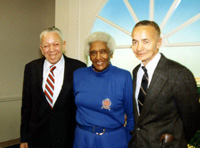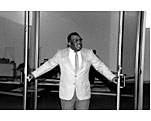Oral History and Videohistory
Collections Highlights
|

C.
Alfred Anderson, Janet Harmon Bragg, and Lewis A.
Jackson, aviators
Ella
B. Howard Pearis, fourth generation resident of Anacostia
in Washington, D.C.
Louis
Purnell, Tuskegee Airman and museum technician

John R. Kinard, Director of the Anacostia Museum, 1979-1989
Smithsonian
predoctoral fellow Michele Gates-Moresi conducted
oral history interviews with curators at the National
Museum of American History about the history of African-American
exhibits at the Smithsonian Institution as part of
her dissertation research.
|
|
Interviewee
Highlights
|
Bernice Johnson Reagon (1942- ), noted composer,
song leader in the 19th century Southwest Georgia
choral tradition, and cultural historian. Reagon
founded the group, Sweet Honey in the Rock, a Grammy
Award-winning African American female a cappella
ensemble with deep musical roots in the sacred
music of the black church in 1973. Reagon served
as a curator at the National Museum of American
History at the Smithsonian in the 1980s. She was
named a MacArthur Fellow in 1989, distinguished
professor of history at American University, and
Curator Emeritus at the National Museum of American
History.
|
|
Pamela
M. Henson, of the Institutional History Division, Smithsonian
Institution Archives, and Jeffrey Hyson, assistant
professor at St. Joseph’s College, conducted
interviews with twelve zoo visitors on Easter Monday
about their families’ Easter Monday traditions
and reminiscences of past Easter Monday visits to the
National Zoo. |
|
Louise
Daniel Hutchinson (1928- ) directed the Research
Center at the Anacostia Museum (AM) from 1974 to
1986. Hutchinson began her museum career in 1971
when she joined the staff of the National Portrait
Gallery (NPG) to conduct researchon the William
E. Harmon and Winold Reiss collections of portraits
of African Americans. As an education specialist
for the NPG, Hutchinson developed programs with
the District of Columbia Public Schools and curriculum
on the history of the District. In 1973, she moved
to the National Park Service's site at the Frederick
Douglass Home where she developed interpretive
programs. In 1974, she returned to the Smithsonian
to direct the Research Center at the AM. During
her tenure, she conducted research in support of
exhibits, developed an oral history program and
the Anacostia Historical Society, and worked to
establish collections and research expertise in
African American history and culture at the AM.
|
|
Other Resources
|
The
holdings described in the Archives
and Manuscripts Catalog document the history
of the Smithsonian Institution since its founding
in 1846; and research in the fields of science,
art, history, and museology. Materials include
institutional records; papers of staff; records
of scientific, historical, and museum organizations;
and audio-visual material from research, exhibits,
and the Institutional History Division's oral
history and videohistory programs.
|
|
The
Institutional
History Division, Smithsonian Institution
Archives began its Oral
History Program in 1973. Program
staff conduct interviews with current and retired Smithsonian
staff and others who have made significant contributions
to the Institution. The purpose of the program is to supplement
the written documentation of the Archives records and manuscript
collections, focusing on the history of the Institution,
research by its scholars, and contributions of its staff.
|
|
The
Smithsonian
Videohistory Program, funded by the Alfred
P. Sloan Foundation from 1986 until 1992, used
video in historical research. Videohistory uses
the video camera as a historical research tool
to record moving visual information. Video works
best in historical research when recording people
at work in environments, explaining artifacts,
demonstrating process, or in group discussion.
The experimental program recorded projects that
reflected the Institution's concern with the conduct
of contemporary science and technology.
|
|

